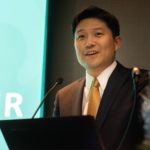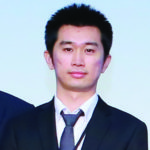Saying that the Hisense-Hitachi joint venture enjoys a 22.3% share of the VRF market in China, Yi Bao, General Manager, Global Business; Administrative Director; Vice Chairman of the Trade Union, Qingdao Hisense Hitachi Air-conditioning Marketing Co., Ltd.; Dharmesh Sawant, Sales Director, Hisense VRF, Qingdao Hisense Hitachi Air-conditioning Marketing Co., Ltd., and Dick Shi, Regional Director, Middle East and North Africa (MENA), Qingdao Hisense Hitachi Air-conditioning Marketing Co., Ltd., tell Surendar Balakrishnan of Climate Control Middle East that the company ís progress is based on the principle of wanting to be trustworthy and on the approach of being consistently innovative. Excerpts from the interview…
Given that you are celebrating the 50th anniversary of the establishment of Hisense, what milestones are you targeting to cross over the next five years? How are you looking to position the company in the globe from an air conditioning point of view?
Yi Bao: The Hisense top management’s strategy is based on research and innovation. When it comes to air conditioning, we are focusing a lot on the VRF technology, which has many advantages. More and more designers and consultants have begun to accept the technology.

Yi Bao
Many years ago, we defined our vision as wanting to build a trustworthy company for global business. We have had a lot of success in the Chinese market with VRF technology – we, as Qingdao Hisense Hitachi Air-conditioning Marketing Company, have 22.3% of the market-share in China. And when we look at the country, China has 40% share of the global VRF market.
In the last five years, we have started building our overseas business strategies. But first, we must understand the market in China. You see, in China, the market is very comprehensive and complex. We have all kinds of architecture, which means there are all kinds of applications for VRF technology in China. We have collected more and more application-related experience in China, which we are now able to share with our overseas partners.
So, where do you see yourself going towards from the market-share of 22.3%?
Bao: Hisense is focused on long-term history. We don’t care about market-share, exactly. Rather, we want to be known as a trustworthy company, worldwide, and as being strong in technological innovation. If you research successful companies, whether they make HVAC products or home appliances, they are trustworthy and have consistently high technological innovation. So, we want to be trustworthy and innovative. Consistent technological innovation means you focus on technology, and if you have new technology you can promote your business. That is our strategy over the next five years, for perhaps a long time into the future.

Dharmesh Sawant
Dharmesh Sawant: China is a very competitive market – the country has 40% share of the global VRF market. And imagine the competition within China among the local players as well as the international companies. So, in that competitive market, us having 22.3% market-share is a big achievement. And that means we have done something right. As you know, B2B business depends on relationship – on how strong our relationship is or how much trust each stakeholder has on the brand. And we have developed that kind of trust in China.
Sometime ago, we thought of going global, because the market in China is reaching saturation point. It meant, taking our expertise to the global market. Whatever we have done in China, we want to take it out to the global market, and we want to project the Hisense brand as a trustworthy brand.
You claim that while globally, companies spend 2-3% of their total revenue on R&D, you spend five per cent of your revenue on R&D. What are you trying to tell the market?
Bao: More and more countries are focusing on the needs of the local market, so you must put your resources – especially R&D resources – to fix the needs of the local market. That’s a responsibility all manufacturers must bear. The needs of the local market vary from one place to the other, be it in the Middle East, the Americas or Europe. The needs of North America are totally different from those of South America. Eastern Europe is different from western Europe, so we must invest a lot on R&D. There should be consistent technological innovation.
We have a lot of pre-developed technology, and maybe we can use this technology in the next two or three years. Hisense has always focused on technology. Within China, if you look at history, some of the Chinese manufacturers have focused on marketing, some others on channel sales, but Hisense has always focused on technology.
Hisense has a comprehensive ability to research into all kinds of technology. For example, our VRF system is the number one inverter-based home air conditioning system in China. In 1999, Hisense built its commercial VRF team. And in 2003, it entered into technical cooperation. Hisense analysed all the VRF technologies from around the world and concluded that Japan has the best technology and that Hitachi is one of the strongest when it came to VRF technology. And so through negotiation, Hisense established a joint venture with Hitachi. Now, a joint venture means different corporate cultures, plus different technical philosophy and business philosophy, but over the last 16 years, we have had a good performance track-record in terms of revenue and profit, which means the cooperation is successful. So, over the next five years, we as the shareholders, operation team or management will focus our vision on being trustworthy and innovative in terms of VRF technology.

Dick Shi
Dick Shi: I want to add one point to what Mr Bao has said. He has just come back from Milan, Italy. In Europe, maybe 90-95% of the air conditioning market is about replacement and retrofit projects, which is totally different from how it is in the UAE, where maybe 80% are new projects. So, as a company, when it comes to the products we use in retrofit projects and to the products we use in new projects, we need to have a different strategy, including sales strategy and R&D strategy. That way, we can meet the needs of different customers and give them a satisfactory experience.
Speaking of retrofits-projects, if a new building, you have instances where you are able to interact with the architects and establish certain approaches from the onset, like planning for dead spaces in high-rises to overcome the issue of piping lengths. In existing buildings, though, you have to work within limitations, correct?
Sawant: In the case of retrofits projects, we are directly communicating with the end user, who is burdened with some features that are pain points and for which he needs a solution. In the case of new buildings, we don’t communicate with the end user, we only communicate with the consultants and contractors, and sometimes what the end user needs is overlooked. So, the strategy in Europe is different in that we focus on the end user, and then we design the product. The focus of R&D is to develop products that will directly benefit the end user.
We benefit from working in Europe, because we use the learning gained there to adopt those features in the Middle East, if suitable. We implement those features over here, and so that is where our global expertise comes into play. To cite an example, in our indoor units, we have an off-coil temperature sensor. This is a unique feature, which helps in fast cooling. It helps in reducing the temperature faster in the room. We developed this feature in Europe and implemented it here in the Middle East, as well. A second example has to do with humidity. Now, humidity control is a feature that other manufacturers also offer. In the case of the Hisense VRF technology, you can set the humidity on the basis of the individual needs of occupants. Somebody has dry skin, so he doesn’t want low humidity, he wants it at 60%. And somebody has good skin texture and wants it at 50%. We recognised this need and, hence, placed the humidity setting in the hands of the end user.
Copyright © 2006-2025 - CPI Industry. All rights reserved.